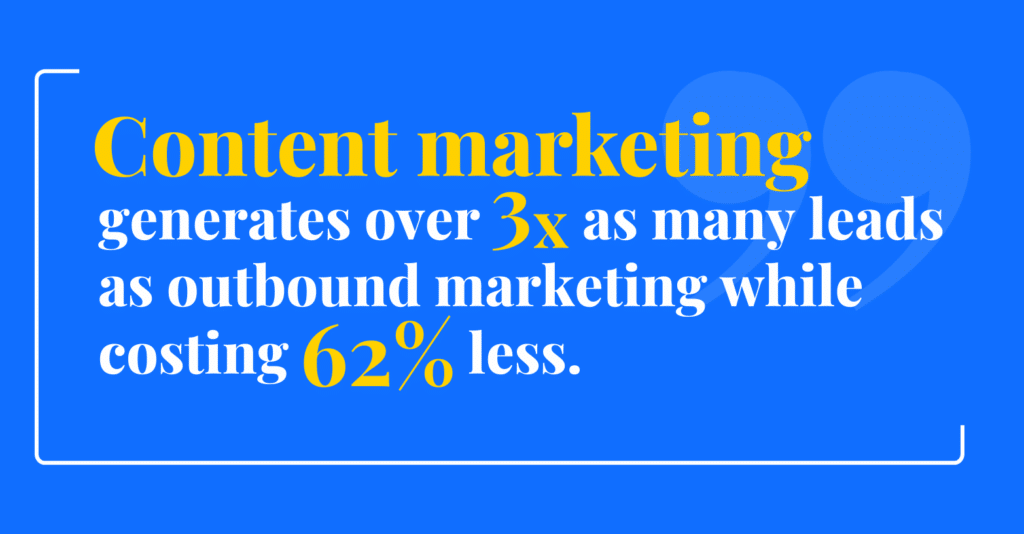Are you on the ‘gram? Maybe you don’t need to be. Maybe you do. It depends on what content your potential shoppers like.
Let’s be honest: the internet doesn’t need another generic “10 Ways to Style Your New Shirt” listicle. What it does need is your unique expertise, delivered through content that cuts through the noise and connects with the right people at the right time.
While your competitors are busy posting daily TikToks that nobody watches or churning out blog posts that nobody reads, smart e-commerce brands are getting strategic about content. They’re creating fewer, better pieces that drive results—because they understand their customers’ content appetites better than anyone else.
The numbers back this up: content marketing generates over 3x as many leads as outbound marketing while costing 62% less. Yet most brands are still pouring money into strategies that don’t deliver this kind of ROI.
Whether you’re just starting your content journey or looking to level up your existing strategy, this guide will help you create high-impact content that drives measurable results for your business.
In this guide:
At Session Interactive, we believe content is a significant driver of eCommerce growth and a powerful medium for building trust, shaping brand identity, and inspiring action.
With over a decade of experience, we help eCommerce brands cut through the noise with content strategies built to engage, educate, and convert. From educational articles to product storytelling and social content, we transform every piece into a revenue-generating asset that deepens customer relationships and fuels long-term success.
Key Challenges of Content Marketing for eCommerce
Creating effective content for eCommerce isn’t simply about producing blog posts or social media updates. Online retailers face specific obstacles that require strategic thinking and consistent execution.
Differentiation in a Crowded Market
Let’s face it—the internet is packed with e-commerce sites selling similar products. When everyone offers comparable items, your content becomes the differentiator.
Most e-commerce brands fall into the trap of producing generic content that fails to showcase their unique value proposition. Your customers can detect inauthenticity from a mile away, and they’ll quickly bounce to competitors who better communicate their expertise and perspective. According to Siege Media’s 2025 content marketing trends report, there are more big spenders in 2025, with 11.3% of content marketers planning to invest over $45,000 per month in content marketing this year. This investment shows how critical distinctive content has become to market success.
Standing out requires developing a distinctive brand voice and creating content that reflects your specific expertise—not just regurgitating the same information your competitors are sharing.
Maintaining Content Quality at Scale
For e-commerce businesses with hundreds or thousands of SKUs, producing high-quality content at scale presents a significant challenge. Many struggle with:
- Inconsistent tone across product descriptions and content pieces
- Outdated content that no longer reflects current products or brand messaging
- Duplicated descriptions that harm SEO performance and create poor user experiences
- Limited resources to regularly update content across multiple platforms and products
Balancing SEO with Shopper-Focused Messaging
Many eCommerce marketers find themselves caught in a tug-of-war: creating content that ranks well in search versus content that effectively speaks to shoppers and drives conversions.
The technical demands of SEO—keyword research, on-page optimization, technical fundamentals—must balance with compelling, human-focused copy that actually sells products. This challenge extends beyond written content to:
- Optimizing product images with appropriate alt text
- Creating video content that’s properly tagged and indexed
- Structuring content for voice search, mobile, and SERP features
- Building a coherent internal linking strategy that guides users through your site
WebFX notes that “with all of that going on, a key content marketing trend in 2025 is the need for diversified SEO strategies. In other words, be flexible with your SEO strategies so you can maintain an omnichannel content marketing strategy.” Without this balanced approach, you risk creating content that either ranks well but fails to convert, or connects with readers but remains undiscovered in search results.
Mapping Content to the Customer Journey
A complete eCommerce content strategy requires materials for every stage of the buyer’s journey—not just the purchasing moment. Many eCommerce businesses overinvest in bottom-funnel content (product pages, promotional offers) while neglecting:
- Top-funnel awareness content that attracts new audiences
- Mid-funnel consideration content that educates and builds trust
- Post-purchase content that reduces returns and drives loyalty
Flowbox emphasizes that “a strong eCommerce content marketing strategy guides buyers through every stage of the sales funnel,” noting that “awareness-level content like blog posts introduces your brand, while detailed product comparisons help customers make purchase decisions.”
Attribution and ROI Measurement Challenges
Unlike direct advertising, the impact of content marketing can be difficult to measure. According to DigitalSilk, “Content marketing is a form of inbound marketing, designed primarily to bring an audience to you, from where those people are already out searching for answers online.” This indirect path makes attribution challenging.
E-commerce businesses often struggle with:
- Connecting content marketing efforts to direct revenue impact
- Understanding attribution across multi-touch customer journeys
- Justifying investment when results may take months to materialize
- Identifying which content types and topics deliver the highest ROI
At Session Interactive, our data-driven approach helps clients measure the true impact of content marketing efforts, ensuring that investments deliver measurable returns. Without clear measurement frameworks, content marketing can be seen as a cost center rather than a revenue driver, making it vulnerable to budget cuts and deprioritization.
Establishing a Cohesive Distribution Plan
Creating great content is only half the battle—distributing it effectively across channels is equally important. eCommerce brands face challenges in:
- Tailoring content appropriately for blogs, email, Instagram, TikTok, YouTube, and other platforms
- Maintaining consistent messaging while adapting to platform-specific formats
- Creating efficient workflows for producing and repurposing content
- Ensuring content reaches target audiences at the right time
Without a strategic distribution plan, even the highest-quality content will struggle to find an audience and deliver meaningful business results.
Personalization and Data Integration
Today’s consumers expect personalized experiences, but many e-commerce businesses struggle to deliver them through content.
Common challenges include:
- Limited use of customer behavior data to drive tailored content experiences
- Gaps in delivering personalized product recommendations or educational materials
- Difficulty integrating content with CRM, CMS, and marketing automation tools
- Balancing personalization with privacy concerns and data protection requirements
Brands like Amazon and Sephora have set high standards for personalization, using purchase history, browsing behavior, and demographic data to create highly tailored content experiences that drive engagement and sales.
When content feels generic and impersonal, engagement suffers and conversion rates decline—particularly for higher-consideration purchases.
Adapting to Evolving Buyer Preferences
Consumer preferences are constantly shifting, and content marketing must evolve accordingly. According to Delivered Social, “In 2025, consumers will expect more than just a product catalogue when they visit online stores. They will want personalized experiences, insightful information, and compelling stories.”
e-commerce businesses face pressure to:
- Keep up with trends like video content, short-form content, and interactive experiences
- Meet evolving consumer expectations for sustainability information and transparent sourcing
- Create mobile-optimized content that performs well across devices
- Embrace new formats like shoppable content and augmented reality
Falling behind these trends can make your brand appear outdated and out of touch with modern consumers.
Benefits of Content Marketing for eCommerce Businesses
While the challenges are real, the benefits of a well-executed content marketing strategy are enormous. Here’s how strategic content can transform your eCommerce business.
Supports the Entire Buyer Journey
Effective content marketing addresses customers’ needs at every stage of their path to purchase:
For the awareness stage, content attracts potential customers who didn’t even know they had a problem your product could solve. For example, Away luggage publishes travel guides that attract travelers before they’ve even considered purchasing new luggage.
For the consideration stage, create comparison guides, detailed product information, and buying guides to help shoppers evaluate options. Wirecutter (owned by The New York Times) excels at this stage with in-depth product reviews and comparison articles.
For the purchase stage, use compelling product descriptions, customer reviews, and FAQs to overcome final objections. Allbirds provides an excellent example with their detailed sustainability information and customer testimonials.
Post-purchase content like tutorials, care guides, and inspiration keeps customers engaged after their initial purchase. Apple’s support content and tutorial videos illustrate how effective post-purchase content builds loyalty and encourages repeat business.
Increases Organic Traffic and Visibility
While paid advertising can drive immediate traffic, content marketing builds sustainable organic visibility over time:
- SEO-optimized content improves your search engine rankings for valuable keywords
- Each piece of content represents another entry point for potential customers to discover your brand
- Evergreen content continues to drive traffic months or even years after publication
- As your content library grows, so does your organic traffic—with diminishing marginal cost
According to PixelCrayons, “Long-Term Value: Content marketing shines when it comes to providing lasting value… Even years after their initial publication, audiences are still drawn to and engaged by well-written blog posts, videos, or downloaded tools” [pixelcrayons.com]. The compounding effect of content marketing means that over time, your customer acquisition costs decrease as your organic traffic increases—a powerful advantage in competitive markets.
Builds Trust and Brand Authority
Simply hawking products doesn’t cut it anymore. Today’s savvy shoppers are looking for brands they can trust, and educational content is your ticket to becoming that trusted resource. When you create content that genuinely helps people solve problems, you’re building goodwill and positive associations that pure advertising simply can’t match. By sharing expertise, showing transparency about your products and practices, and consistently delivering valuable insights, you transform your brand from just another seller into a go-to authority.
Look at how Beardbrand has mastered this approach. They’ve cultivated a fiercely loyal following through their YouTube channel and blog focused entirely on beard care education. By offering comprehensive grooming guides, honest product information, and lifestyle content that resonates with their audience, they’ve established themselves as the undisputed authority in men’s grooming. When their audience is ready to buy, their products are the natural, trusted choice. When customers believe in your expertise, that confidence extends directly to your products and services.
Improves Product Page Performance and Conversions
Content marketing applies to product pages too. When you craft detailed, benefit-focused product descriptions, you’re not just listing features; you’re helping customers understand exactly why they should buy. High-quality visuals reduce purchase uncertainty by showing products from every angle and in context. User-generated content like reviews and customer photos provides that crucial social proof that builds confidence in hesitant shoppers. Smart FAQ sections and additional information proactively address common objections before they become roadblocks to purchase. When you bring all these content elements together, you create product pages that don’t just inform—they convert, turning casual browsers into decisive buyers.
Boosts Customer Retention and Lifetime Value
Here’s a hard truth: acquiring a new customer costs anywhere from 5 to 25 times more than keeping an existing one. Smart content marketing helps you maximize the value of customers you’ve already won.
Post-purchase emails and guides ensure customers get full value from what they’ve bought, reducing buyer’s remorse and returns. Educational content about product use, care tips, and complementary items naturally encourages additional purchases without aggressive upselling. Exclusive content for your existing customer base creates a sense of belonging to something special, while regular newsletter content keeps your brand front-of-mind between purchases.
These retention-focused content strategies increase customer lifetime value and transform one-time purchasers into passionate brand advocates who bring their friends along.
Amplifies Reach Through Multi-Channel Distribution
Great content creates natural opportunities for engagement across your entire marketing ecosystem.
A single piece of quality content can fuel multiple channels: that in-depth blog post becomes the foundation for your email newsletter, which drives social media conversations, which inspire video content for YouTube, which can be repurposed across other platforms.
Downloadable guides and resources generate leads while building your email list, creating a continuous cycle of engagement. This multi-channel approach ensures your brand maintains visibility wherever your customers spend their digital time, creating multiple touchpoints that reinforce your message and keep you top-of-mind.
Enables Scalable, Long-Term Growth
Unlike paid advertising that vanishes the moment you stop spending, content marketing creates durable assets with lasting value. Those blog posts, videos, and guides continue driving traffic and sales for years, not hours.
Smart brands regularly update and repurpose their best content to extend its lifespan and reach, squeezing maximum value from every piece. As your content library expands, so does your organic visibility—and the beauty is that the ROI of content marketing typically improves over time as your distribution channels mature and creation processes become more efficient.
This inherent scalability makes content marketing an especially valuable approach for eCommerce businesses focused on building sustainable, long-term growth rather than quick-hit sales.
Provides Valuable Insights Into Customer Behavior
Content engagement offers a fascinating window into what your customers really care about. Performance metrics reveal which topics and formats truly resonate with your audience, while comment sections and social engagement provide direct feedback and surface questions you might never have anticipated. Email response rates clearly show which offerings generate genuine interest, and video watch rates highlight which products or features capture attention most effectively.
These rich behavioral insights can inform your content strategy and guide product development, customer service approaches, and overall business direction. The result? A business that’s increasingly aligned with what your customers actually want, not what you think they want.
How to Create an Effective eCommerce Content Marketing Plan
Define Your Goals
Start with clear, measurable objectives tied directly to business outcomes. Whether you want to increase organic traffic, boost conversion rates, reduce cart abandonment, or build your email list, your goals will determine what content you create and how you measure success. Always align your content metrics with broader business KPIs to demonstrate real impact.
Understand and Segment Your Target Audience
Generic content appeals to no one. Develop detailed customer personas based on demographics, shopping behaviors, and pain points, then segment your strategy accordingly. A kitchen supply retailer might create separate content streams for professional chefs versus home cooking enthusiasts—each with distinct concerns and information needs.
Map the Customer Journey and Identify Content Needs
Create content for every stage: awareness (educational blog posts, trend reports), consideration (buying guides, product comparisons), decision (detailed product descriptions, user reviews), and post-purchase (setup guides, maintenance tips). This ensures you’re providing value throughout the entire customer relationship.
Conduct SEO and Competitor Research
Understand what your potential customers are searching for by researching both transactional keywords (“buy organic cotton sheets”) and informational keywords (“how to choose bed sheets”). Analyze competitors to identify content gaps you can fill with superior materials that differentiate your brand.
Choose the Right Content Types for eCommerce
Mix formats to create rich customer experiences: product-focused content (detailed descriptions, high-quality photos), educational content (how-to guides, tutorials), user-generated content (reviews, customer photos), and interactive elements (product selectors, size guides). Video content is particularly effective for eCommerce, according to Semrush research.
Build a Strategic Content Calendar
Organize your efforts around seasonal trends, product launches, and industry events. Your calendar should include publication dates, topics, target keywords, distribution channels, and team responsibilities. Leave room for trending topics while maintaining a consistent publishing schedule.
Create Content that Converts
Focus on guiding customers toward solutions, not just pushing products. For product descriptions, emphasize benefits over features and use sensory language. In blogs, naturally integrate product mentions where relevant. For emails, personalize recommendations and balance educational content with promotional offers.
Distribute Content Across Relevant Channels
Ensure your content reaches your audience where they already spend time—your website, email, social media platforms, and marketplaces. Adapt content for each channel’s format and audience expectations, and consider partnerships with influencers and complementary brands to extend your reach.
Track Performance and Optimize Over Time
Continuously measure results and refine your approach. Track key metrics like traffic sources, engagement, conversion rates, and customer feedback. Use these insights to double down on what works, improve or replace underperforming content, and identify new opportunities based on audience behavior.
10 eCommerce Content Marketing Tips, Tactics, and Insights
Beyond the foundational strategy, these proven tactics can help take your eCommerce content marketing to the next level.
1. Create Bundled Content Experiences
Instead of showcasing products in isolation, create immersive content experiences that position your items as part of larger solutions or lifestyles.
For home goods retailers, this might mean creating shoppable room designs where customers can envision how multiple products work together. Fashion brands can build complete outfit recommendations that drive multiple purchases, while food retailers might develop recipe collections with all necessary ingredients just a click away. Hobby and craft stores can excel with comprehensive project guides that include all required supplies, making it effortless for customers to gather everything they need.
This contextual approach not only helps shoppers visualize products in use but naturally increases average order values by encouraging complementary purchases.
2. Use Short-Form Video on Product Pages
Today’s consumers increasingly prefer video over text for product research. Embedding short, engaging videos directly on product pages can significantly boost conversion rates.
Effective product videos include:
- Quick overviews of key features (30-60 seconds)
- Demonstrations of the product in use
- Size comparisons and scale references
- Customer testimonials and real-world usage
Platforms like TikTok and Instagram Reels have conditioned consumers to engage with short-form content. Bringing this format to your product pages can capture attention and answer questions more effectively than text alone.
3. Build Educational Content Around Product Categories
When you create comprehensive educational content for each of your major product categories, you’re doing more than just informing customers—you’re establishing your brand as the authority customers can trust.
Start with in-depth buying guides that walk shoppers through all the key considerations they should weigh before making a purchase. Complement these with detailed comparison charts that make it easy to evaluate different options at a glance. Add expert advice on selection criteria from your team’s specialists to demonstrate genuine expertise, and include sections on common purchasing mistakes to help customers avoid potential disappointment.
An educational approach transforms your position from just another seller to a trusted advisor, building the confidence that leads directly to purchase decisions.
4. Test Content Placement on PDPs (Product Detail Pages)
The organization and hierarchy of content on product pages significantly impacts conversion rates. Systematic testing of content placement can identify optimal arrangements for your specific audience.
Elements to test include:
- Position of customer reviews (above the fold vs. below)
- Placement of video content relative to product images
- Location of technical specifications and detailed information
- Positioning of related product recommendations
Small changes in content layout can yield surprising improvements in engagement and conversion—making continuous testing an essential practice.
5. Develop Post-Purchase Content Journeys
The moment after a customer clicks “buy” marks the beginning of what could be a lifelong relationship if you nurture it correctly.
Create a structured content journey that begins with order confirmation content designed to build excitement about their purchase decision. Follow with shipping and delivery communications that reduce anxiety and maintain anticipation. Once the product arrives, provide thoughtful unboxing and setup guides that ensure a successful first experience, along with product care information that extends its lifespan. Share creative usage ideas that help customers get maximum value and satisfaction from their purchase, and strategically introduce cross-sell recommendations for truly complementary products.
The systematic approach to post-purchase communication transforms transactional buyers into loyal repeat customers and enthusiastic brand advocates who spread the word about their positive experience.
6. Include Schema Markup on Content Pages
Technical optimization enhances content visibility and functionality. Implementing structured data markup helps search engines better understand and display your content.
Important schema types for eCommerce include:
- Product schema for product pages
- Review schema for customer ratings
- FAQ schema for frequently asked questions
- How-to schema for tutorial content
- Article schema for blog content
When properly implemented, schema markup can help your content appear in rich snippets, knowledge panels, and other enhanced search results—increasing visibility and click-through rates.
7. Create “Problem-Solution” Content Instead of Just Product-Focused Posts
Most customers begin their journey with a problem, not a product in mind. Content that addresses specific customer problems creates natural pathways to your products as solutions.
Examples of problem-solution content include:
- “How to keep your skin hydrated during winter” for skincare retailers
- “Solving small kitchen storage challenges” for home goods sellers
- “Preventing muscle soreness after workouts” for fitness equipment brands
- “Managing pet hair in your home” for pet supply companies
This approach connects with customers earlier in their journey and positions your products as natural solutions rather than forced promotions.
8. Segment Your Content Strategy by Funnel Stage
Different types of content serve different purposes along the customer journey. Deliberately segmenting your content strategy ensures appropriate coverage at each stage.
A segmented approach might include:
- Top-funnel content focus: SEO-optimized blog posts, trend reports, social content
- Mid-funnel content focus: Buying guides, comparison content, detailed FAQs
- Bottom-funnel content focus: Product descriptions, customer testimonials, shipping information
- Retention content focus: Usage guides, care information, loyalty program content
By tracking which content types drive movement between funnel stages, you can refine your strategy to optimize the entire customer journey.
9. Repurpose Blog Content into Landing Pages for Paid Campaigns
Your highest-performing blog content contains valuable insights about what resonates with your audience—insights that can improve paid campaign performance.
When repurposing blog content for paid landing pages:
- Maintain the educational value that made the original content successful
- Add more direct calls to action and product connections
- Optimize page structure for conversion rather than reading time
- Streamline content for faster comprehension
- A/B test different versions to identify the most effective approach
This strategy leverages your content investment across multiple channels and creates stronger alignment between organic and paid efforts.
10. Build a Content-First Email Welcome Series
First impressions can make or break customer relationships, which is why a thoughtful welcome email series is so crucial for e-commerce brands. Instead of immediately pushing for sales, start by introducing your brand story and values in a way that creates emotional connection. Follow with genuinely useful educational content related to your product category that demonstrates expertise without overtly selling. Share authentic customer success stories and testimonials that build social proof and help new subscribers envision similar positive outcomes. Offer behind-the-scenes glimpses into your product development or company culture to foster transparency and authenticity. Only after establishing this foundation of value should you gradually introduce your product offerings.
A value-first approach builds stronger relationships and trust that drives significantly higher long-term engagement and purchase rates compared to promotion-heavy welcome sequences.
Overcome eCommerce Content Marketing Challenges with Session Interactive
Navigating the complex world of eCommerce content marketing requires strategic thinking, creative execution, and consistent measurement. At Session Interactive, we specialize in helping mid-sized eCommerce companies leverage content to drive sustainable growth.
Our data-driven approach ensures that every content marketing strategy we develop is backed by solid research and measurable results. We’ve helped eCommerce clients across various industries increase organic traffic, improve conversion rates, and build lasting customer relationships through strategic content marketing.
Successful eCommerce content marketing requires strategic timing and targeted content development, as demonstrated in our partnership with educational brand Insect Lore. Insect Lore created the Butterfly Garden™ – The Original Raise and Release Butterfly Growing Kit – over 50 years ago. Today, their products include additional live insect kits, including Ladybug, Mason Bee, Praying Mantis growing kits, and insect-related playthings for families and classrooms.
They partnered with us to enhance their online visibility and SEO performance before their peak sales season, which runs from February to June. This timing was crucial—they needed to ramp up digital efforts well before their busy period to maximize impact.
Our approach combined SEO expertise with content strategy development. Since Insect Lore already had high rankings for core products, we crafted a strategy to enhance their digital footprint without disrupting established performance. We focused on developing a robust content strategy with a clear roadmap and content calendar specifically designed to capture informational searches around insect topics.
The results exceeded expectations: Within just the first three months, Insect Lore’s blog generated 27.4K clicks and 2.38M impressions. The brand also ranked for 4.2K additional keywords. By November, those numbers had grown to 74.5K clicks and 7.79M impressions.
This case demonstrates how a well-timed content marketing strategy can significantly expand an eCommerce brand’s digital presence while supporting its seasonal business cycles. The key was creating valuable educational content that aligned with customer interests and search behavior, establishing Insect Lore as an authority in their niche.
Ready to transform your eCommerce content marketing? Contact Session Interactive today to discuss how we can help you achieve your business goals through strategic content marketing.






